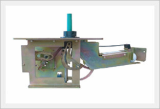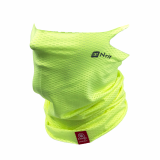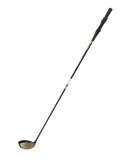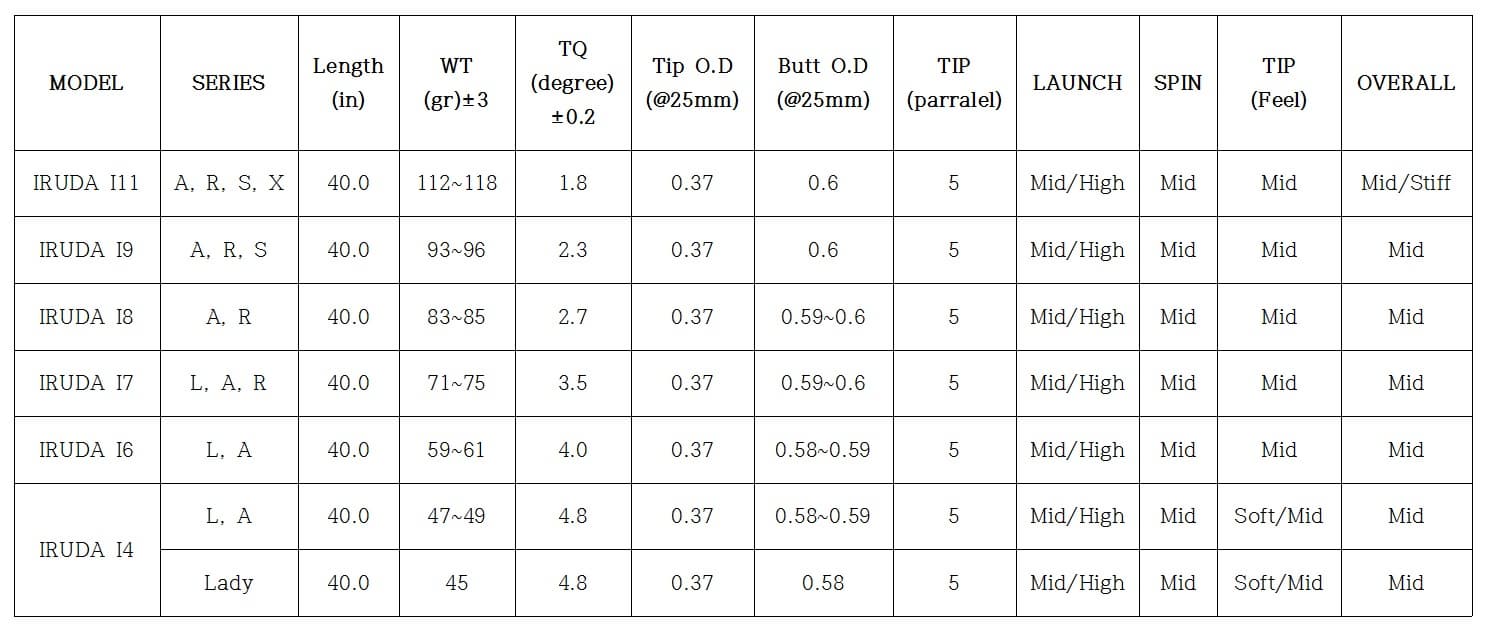IRUDA IRON GOLF SHAFT
Negotiable Min Order Quantity Unit
- Required Quantity
-
- Place of Origin
- Payment Terms
- Negotiable
- Production method
- Negotiable
- Shipping / Lead Time
- Negotiable / Negotiable
- Keyword
- iron, golf club, golf shaft, shafts
- Category
- Golf
MFS KOREA
- Verified Certificate
-
11



| Product name | IRUDA IRON GOLF SHAFT | Certification | - |
|---|---|---|---|
| Category | Golf | Ingredients | - |
| Keyword | iron , golf club , golf shaft , shafts | Unit Size | - |
| Brand name | - | Unit Weigh | - |
| origin | Stock | - | |
| Supply type | - | HS code | - |
Product Information
IRUDA I(Iron)
Technology : DEDE, CFI, TTR
<DEDE>
Deformation of Energy Curve Graphite shaft designers have long relied on borrowed approaches from other engineering disciplines. These conventional approaches, such as "EI Curve," are based on zonal frequency, deflection, or 3-point bending and have serious limitations -- they have limited predictive capabilities and do not measure a shaft's entire length. To go beyond simple beam theory, Matrix uses a proprietary Deformation of Energy Analysis to create a Deformation of Energy Curve (DE Curve).
DE Analysis, the Matrix method for evaluating how shaft construction relates to performance, reveals that energy that should be delivered to the clubhead and ball can be deformed and lost through inefficiencies in the shaft's design. With these energy loss points revealed, Matrix Shafts are can be built with minimized or eliminated areas of instability. Less energy loss points and more efficient energy transfer allow for a highly stable impact position, higher MOI, and more energy and power delivered to the ball.
The DE Curve is a golf-specific measurement of the entire shaft created by Matrix. This breakthrough provides our engineers with a predictive resolution for the design's role in effecting Spin Rate, Launch Angle, and Ball Speed. For the club builder and golfer, this predictive ability allows for faster and more accurate club fitting. For Matrix engineers, being able to predict spin, launch, and speed allows for faster and more accurate creations of future iterations.
KEY POINTS
- DE Analysis reveals energy loss points and inefficiencies
- DE Curve predicts spin, launch, and ball speed
<CFI>
Circumferential Flexural Integrity is an innovative layup method devised to insure a shaft's flexing properties are consistent around the 360� circumference.
It is imperative to keep these values as close together as possible during manufacturing to ensure consistent dynamic response and output performance of the shaft. A shaft must have the same flex characteristics around it's circumference before it can be truly matched to another shaft. Matrix also manufactures a testing apparatus called The Universal. This was designed to provide technically advanced club builders and OEMs an opportunity to test any shaft on the market.
KEY POINTS
- Every Matrix Shaft is tested for CFI
- CFI checks that each shaft has a consistent flex, despite the orientation
<TTR>
Tip Torsional Resistance is a proprietary stability method of controlling the unwanted deformation in the lower sections of a golf shaft.
TTR greatly reduces the tendency of the tip of a shaft to twist in the impact zone and significantly reduces the longitudinal deformation ("S" curve) while in dynamic motion. This added structural stability results in controlled side launch deviation, more centered contact, more consistent spin results, and higher energy transfer into the golf ball. This combination yields explosive distance and straighter Shots.
KEY POINTS
- Used in woods, TTR can dramatically tighten dispersion and aid in solid contact
- Used in irons, TTR may have its most dramatic applications, thus eliminating the deformations that come with using steel iron shafts
B2B Trade
| Price (FOB) | Negotiable | transportation | - |
|---|---|---|---|
| MOQ | Negotiable | Leadtime | Negotiable |
| Payment Options | Negotiable | Shipping time | Negotiable |
- President
- Jun Jai-hong
- Address
- 799-9, Yeoksam 1-dong, Gangnam-gu, Seoul, Korea
- Product Category
- Golf
- No. of Total Employees
- 1-50
- Company introduction
-
MFS GOLF is...
MFS Golf started in 1998 with Millenium Golf, and reorganized the brand as "MFS" brand in 2001. Currently, we are leading the golf industry with "Orange Syndrome". We launched the elite brand, MATRIX GOLF CLUB in March 2006, which signified a further step in VIP Marketing.
MFS Golf will continue the traditional approach through “OZIK" , "IRUDA", and "SQRT" models.
[Explanation of MFS brand name]
* “OZIK”. This is Korean and it is a “Only” in English.
It means that MFS golf club is the only one the worlds most unique performance club.
* “IRUDA”. This is Korean and it is a “Achieve”, “Accomplish” in English.
It means that “IRUDA” will make your longer distance dream come true.
* “SQRT”. This is a “Square root”.
It means that “SQRT” will multiply your distance.
[Effort of MFS GOLF]
1. MFS Golf prioritizes on product improvement, above all else.
We persevere in R/D, and prioritize our personnel and financial efforts under the motto, "Customer satisfaction is the optimum indicator in golf club businesses".
2. We take a great pride in being a leading golf club manufacturer, and concentrate on technology improvement.
We have established our "Fitting System" based on 13,200 fitting analysis data, and exclusive manual development, and cutting technology. We have also developed "fitting equipment" through our own technology, and are supplying the service to the customers in our country.
3. Not only are we opting to be an asset in the golf community, but also to the society. We operate MFS Golf Team, provide support to the junior players, and try to give back to the society.
[MFS GOLF’s Resolution to be a global golf company]
21st Century is definitely a time for change, and we intend to step further by continuously developing the golf industry, and step into the domain of global corporations.
- Main Product
Related Products

auto golf tee-up machine

TUBE9 COOL EAR LOOP SUMMER BALACLAVA COOLING
_,_Hand_Grip_Strengthener,_Hand_gripper,_Hand_exerciser_2.jpg)
GD IRON GRIP EXT 90(Resistance : 25~90kg) , Hand Grip Strengthener, Hand gripper, Hand exerciser

Easy Power Grip,Golf
_,_Hand_Grip_Strengthener,_Hand_gripper,_Hand_exerciser_2.jpg)
GD GRIP PRO-70 (Resistance : 25~70kg) , Hand Grip Strengthener, Hand gripper, Hand exerciser





































 South Korea
South Korea


![cbe9caa6_7d162556_3739_4990_b72b_6fc60d43274a MFS luxurious Man's Caddy Bag SET[MFS Golf]](https://web.tradekorea.com/product/712/358712_02/cbe9caa6_7d162556_3739_4990_b72b_6fc60d43274a.jpg)
